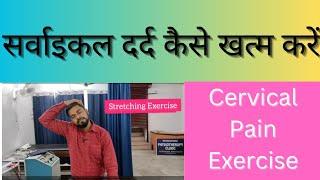
सर्वाइकल दर्द कैसे खत्म करें| How do I Relieve Neck Pain
सर्वाइकल दर्द कैसे खत्म करें| How do I Relieve Neck Pain
cervical pain exercises
cervical pain exercises
neck pain exercise at home
Neck pain relief
cervical pain
cervical spondylitis exercise
cervical exercise
cervical spondylitis
cervical symptoms
cervical exercise in Hindi
cervical exercise at home
गर्दन के दर्द का इलाज एक्सरसाइज
गर्दन के दर्द का इलाज घरेलू
गर्दन की एक्सरसाइज कैसे करें
सर्वाइकल के लक्षण
सर्वाइकल का इलाज
सर्वाइकल क्या होता है
गर्दन में सूजन का इलाज एक्सरसाइज
सर्वाइकल की एक्सरसाइज कैसे करें
गर्दन के दर्द की एक्सरसाइज घर पर कैसे करें
گردن درد کی ورزش
گردن درد کی ورزش گھر پر کیسے کریں
گردن درد اکسرسایز
سروائیکل کیا ہوتا ہے
سروائیکل اسپانڈی لائٹس
سروائیکل کینسر سائز کیسے کریں
Cervical spondylitis, also known as cervical spondylosis, is a degenerative condition of the cervical spine (the upper part of the spine, located in the neck). It is caused by age-related wear and tear of the spinal disks and bones in the neck.
As the disks and bones deteriorate, they may cause pressure on the spinal cord or nerves in the neck, resulting in symptoms such as neck pain, stiffness, and numbness or weakness in the arms, hands, or legs. Other symptoms may include headaches, dizziness, and difficulty with balance and coordination.
Risk factors for cervical spondylitis include aging, a history of neck injury, poor posture, and certain occupations that involve repetitive neck movements. Treatment for cervical spondylitis may include physical therapy, medications to manage pain and inflammation, and in some cases, surgery.
To perform cervical exercises safely and effectively, it is recommended to follow the guidance of a certified fitness or physical therapy professional.
Cervical isometric exercises are a type of exercise that involves contracting the muscles of the neck without moving the head or neck. These exercises are often used to strengthen the muscles of the neck and improve posture.
Here's an example of a cervical isometric exercise:
Sit or stand up straight, with your shoulders relaxed and your chin tucked in slightly.
Place your right hand on the side of your head, just above your ear.
Push your head against your hand, using your neck muscles to resist the pressure.
Hold the contraction for 5-10 seconds, then release.
Repeat on the other side, using your left hand to apply pressure.
You can also do this exercise by placing your hands behind your head and pushing your head back against your hands.
Chin Tucks: Sit or stand with your shoulders relaxed and your head in a neutral position. Slowly pull your chin in toward your neck, creating a double chin. Hold for a few seconds, then release. Repeat for several repetitions.
Remember to move slowly and gently, and stop if you experience any pain or discomfort. It is always best to consult with a healthcare professional before beginning any new exercise routine.
follow on Facebook -https://www.facebook.com/profile.php?id=100064022200701&mibextid=ZbWKwL
Follow on Instagram -https://www.instagram.com/zeeshan_physiovedic/
#cervicalpain
#cervical
#trending
Physiovedic Physiotherapy Clinic
Dr-Zeeshan Ali(PT)
consultant Physiotherapist
Opp-Rajendra Nagar Hospital Rajendra Nagar Lucknow
Contact us -9807734275
Email - [email protected]
Visit our website -www.physiovedic.com
cervical pain exercises
cervical pain exercises
neck pain exercise at home
Neck pain relief
cervical pain
cervical spondylitis exercise
cervical exercise
cervical spondylitis
cervical symptoms
cervical exercise in Hindi
cervical exercise at home
गर्दन के दर्द का इलाज एक्सरसाइज
गर्दन के दर्द का इलाज घरेलू
गर्दन की एक्सरसाइज कैसे करें
सर्वाइकल के लक्षण
सर्वाइकल का इलाज
सर्वाइकल क्या होता है
गर्दन में सूजन का इलाज एक्सरसाइज
सर्वाइकल की एक्सरसाइज कैसे करें
गर्दन के दर्द की एक्सरसाइज घर पर कैसे करें
گردن درد کی ورزش
گردن درد کی ورزش گھر پر کیسے کریں
گردن درد اکسرسایز
سروائیکل کیا ہوتا ہے
سروائیکل اسپانڈی لائٹس
سروائیکل کینسر سائز کیسے کریں
Cervical spondylitis, also known as cervical spondylosis, is a degenerative condition of the cervical spine (the upper part of the spine, located in the neck). It is caused by age-related wear and tear of the spinal disks and bones in the neck.
As the disks and bones deteriorate, they may cause pressure on the spinal cord or nerves in the neck, resulting in symptoms such as neck pain, stiffness, and numbness or weakness in the arms, hands, or legs. Other symptoms may include headaches, dizziness, and difficulty with balance and coordination.
Risk factors for cervical spondylitis include aging, a history of neck injury, poor posture, and certain occupations that involve repetitive neck movements. Treatment for cervical spondylitis may include physical therapy, medications to manage pain and inflammation, and in some cases, surgery.
To perform cervical exercises safely and effectively, it is recommended to follow the guidance of a certified fitness or physical therapy professional.
Cervical isometric exercises are a type of exercise that involves contracting the muscles of the neck without moving the head or neck. These exercises are often used to strengthen the muscles of the neck and improve posture.
Here's an example of a cervical isometric exercise:
Sit or stand up straight, with your shoulders relaxed and your chin tucked in slightly.
Place your right hand on the side of your head, just above your ear.
Push your head against your hand, using your neck muscles to resist the pressure.
Hold the contraction for 5-10 seconds, then release.
Repeat on the other side, using your left hand to apply pressure.
You can also do this exercise by placing your hands behind your head and pushing your head back against your hands.
Chin Tucks: Sit or stand with your shoulders relaxed and your head in a neutral position. Slowly pull your chin in toward your neck, creating a double chin. Hold for a few seconds, then release. Repeat for several repetitions.
Remember to move slowly and gently, and stop if you experience any pain or discomfort. It is always best to consult with a healthcare professional before beginning any new exercise routine.
follow on Facebook -https://www.facebook.com/profile.php?id=100064022200701&mibextid=ZbWKwL
Follow on Instagram -https://www.instagram.com/zeeshan_physiovedic/
#cervicalpain
#cervical
#trending
Physiovedic Physiotherapy Clinic
Dr-Zeeshan Ali(PT)
consultant Physiotherapist
Opp-Rajendra Nagar Hospital Rajendra Nagar Lucknow
Contact us -9807734275
Email - [email protected]
Visit our website -www.physiovedic.com
Тэги:
#cervical #cervical_spondylitis #cervical_exercise #exercise_cervical #cervical_pain #cervical_symptoms #cervical_exercise_at_home #pain_cervical_exercise #neck_pain #neck_pain_relief #cervical_k_lakshan #cervical_hota_kya_hai #gardan_me_dard_ka_ilajКомментарии:
Soap Technique: Dancing Waves - Cold Process Soap Technique by Fraeulein Winter
Fraeulein Winter - Soap & DIY
सर्वाइकल दर्द कैसे खत्म करें| How do I Relieve Neck Pain
Physiovedic Physiotherapy Clinic
I Built CRIMINAL BASE Under Brookhaven RP..
Poke - Brookhaven
Uzbek music
MusicFactory
DIOS DE AMORES ️ Santa Eucaristía ️- Música Católica 100% - Canciones católicas en español
Diego & Martina Valdivieso 🎵🎶


























